When harvesting wild foods from streams, you must test water quality for safety. Test for E. coli levels (should be below 126 CFU/100mL) and heavy metals like lead and mercury. Conduct tests at least three times per season, especially after rainfall when contamination spikes. Use EPA-approved methods rather than simple presence/absence tests, and document all results. Wait 48 hours after storms before harvesting. The proper testing protocol can mean the difference between a healthy harvest and potential illness.
Testing Stream Water Before Wild Food Harvesting
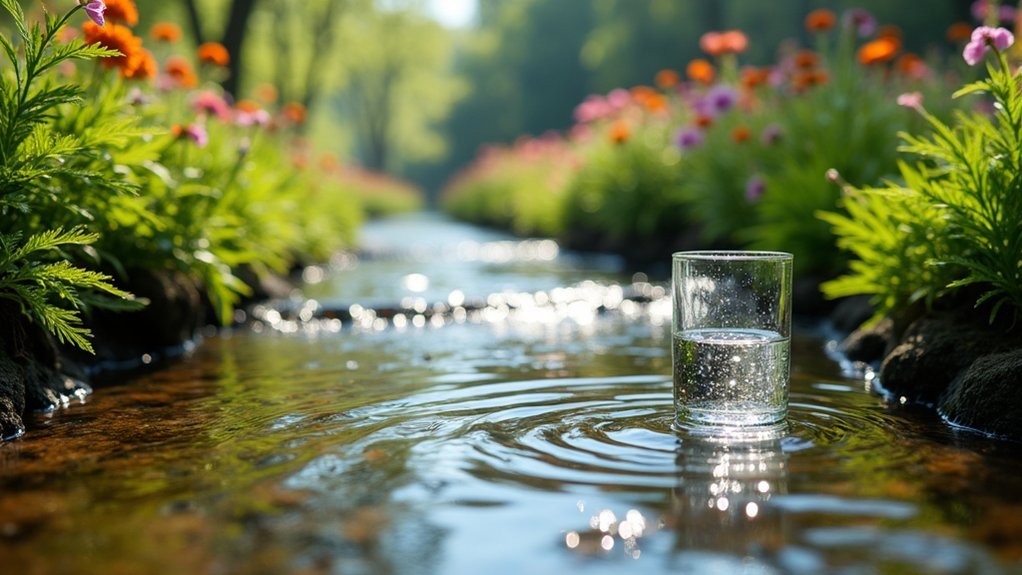
When you're planning to harvest wild foods from streams, testing the water quality first isn't just good practice—it's vital for safety.
You need to specifically check for total coliforms and generic E. coli, which are key indicators of microbial contamination.
The FSMA Produce Safety Rule requires harvesting water to have non-detectable levels of generic E. coli.
Food safety regulations mandate harvesting water must contain zero detectable generic E. coli to meet compliance standards.
Use EPA 1603 analysis or equivalent methods for your testing, as presence/absence tests won't satisfy compliance audits.
Test water at least three times per season—at the beginning, middle, and close to harvest time. This is especially important for surface water sources like streams.
Don't forget to maintain thorough documentation of all water quality test results. These records are essential for audits and demonstrating compliance with food safety regulations.
Common Bacterial Contaminants in Urban Waterways
Urban waterways commonly harbor E. coli bacteria from sewage overflows, pet waste, and failing septic systems that can contaminate wild foods you harvest.
Heavy rainfall washes these contaminants into streams through storm drains and impervious surfaces, markedly increasing bacterial levels after wet weather events.
You'll need to be especially cautious when harvesting after storms, as urban runoff can spike E. coli counts well above the safe threshold of 126 CFU per 100 mL.
E. Coli Contamination Sources
Invisible threats lurk in urban waterways, with E. coli being among the most concerning bacterial contaminants you'll encounter when harvesting wild foods. This bacteria primarily enters streams through fecal matter from both humans and animals.
You'll find higher E. coli levels after rainstorms when urban runoff washes contaminants into waterways. Sewage overflows during heavy rainfall events can release untreated waste directly into streams.
Don't overlook wildlife contributions—birds and mammals frequently contaminate water through their droppings.
The problem worsens in highly urbanized areas where impervious surfaces prevent natural filtration. Before collecting wild edibles near streams, conduct a drinking water test to check for E. coli contamination, especially after rain or during seasonal snowmelt when bacteria levels typically spike.
Urban Runoff Concerns
Beyond E. coli, a complex cocktail of bacterial contaminants flows through urban waterways, threatening your wild food harvesting safety. Urban surfaces collect pollutants that rainfall washes directly into streams, greatly increasing harmful bacteria levels after storms.
Regular water tests are essential before foraging near urban areas. When monitoring water quality, look for generic E. coli levels of 126 CFU or MPN or less, as higher measurements indicate potential fecal contamination.
Total coliforms are equally important indicators—their presence suggests harmful bacteria might be lurking in the water.
Remember that bacterial concentrations fluctuate considerably, especially following rain events. What tested safe yesterday might be dangerous today.
Conducting timely water quality assessments directly before harvesting will help protect you from bacterial contamination that's invisible to the naked eye.
Essential Water Quality Parameters for Urban Foragers
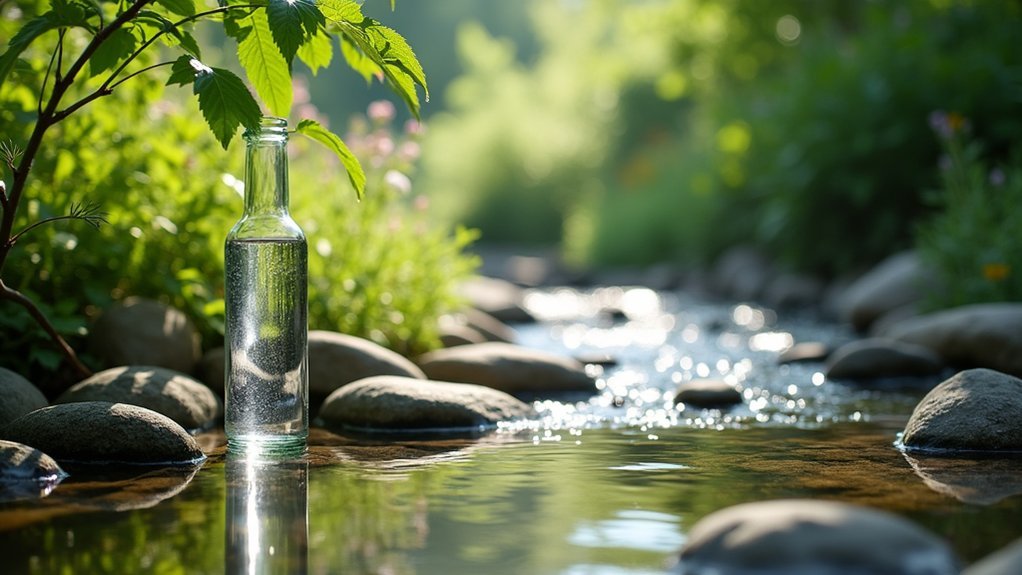
You'll need to understand key microbial indicators when testing stream water, particularly focusing on E. coli levels below 126 CFU or MPN to ascertain safety for wild food harvesting.
Beyond bacteria, you should test for heavy metals that commonly accumulate in urban waterways and can contaminate edible plants growing nearby.
Conducting these tests at least three times per season—especially at the beginning, middle, and close to harvest time—will help you identify safe foraging locations and avoid potentially contaminated water sources.
Subheading Discussion Points
Before venturing into urban foraging around streams and waterways, you'll need to understand several critical water quality parameters that confirm your wild harvests are safe for consumption. Most importantly, test for generic E. coli, confirming levels don't exceed 126 CFU/100mL. Portable water test kits can help you conduct preliminary assessments in the field.
| Parameter | Testing Frequency | Significance |
|---|---|---|
| E. coli | 3x per season | Primary safety indicator |
| Total Coliforms | Annually for wells | Required for USDA audits |
| EPA 1603 Analysis | Before harvest | FSMA compliance |
Remember to test surface water at the start of irrigation, mid-season, and pre-harvest to monitor quality changes. This systematic approach confirms you're not only gathering delicious wild foods but also protecting yourself from potential waterborne contaminants.
Microbial Testing Basics
Three critical microbial parameters stand at the forefront of water quality testing for urban foragers.
First and most essential is generic E. coli, which shouldn't exceed 126 CFU or MPN for water used around wild foods.
Second, if you're using stream water for postharvest processes, test for total coliforms, which should be absent entirely.
Third, document all results meticulously—this isn't just paperwork, but your safety record.
You'll need to test surface water at least three times per season: before harvest begins, mid-season, and right before gathering your wild bounty.
Don't rely on simple presence/absence water test kits, as they won't satisfy FSMA requirements.
Instead, choose EPA 1603 analysis methods.
Heavy Metal Concerns
While microbial testing forms the foundation of water safety, heavy metal contamination presents an equally serious threat to urban foragers. You should specifically test for lead, mercury, and cadmium in stream water before harvesting wild foods, as these toxic metals can accumulate in aquatic plants and organisms.
The EPA sets strict standards—0.015 mg/L for lead and 0.002 mg/L for mercury—that you'll need to verify your foraging areas meet. Though water test kits are available for home use, they often can't detect the low concentrations that may still be harmful. Instead, rely on certified laboratories for accurate results.
Don't forget to research your local area's industrial history and environmental conditions, as urban runoff can notably increase heavy metal levels in nearby water bodies, compromising wild food safety.
DIY Testing Methods vs. Professional Laboratory Analysis
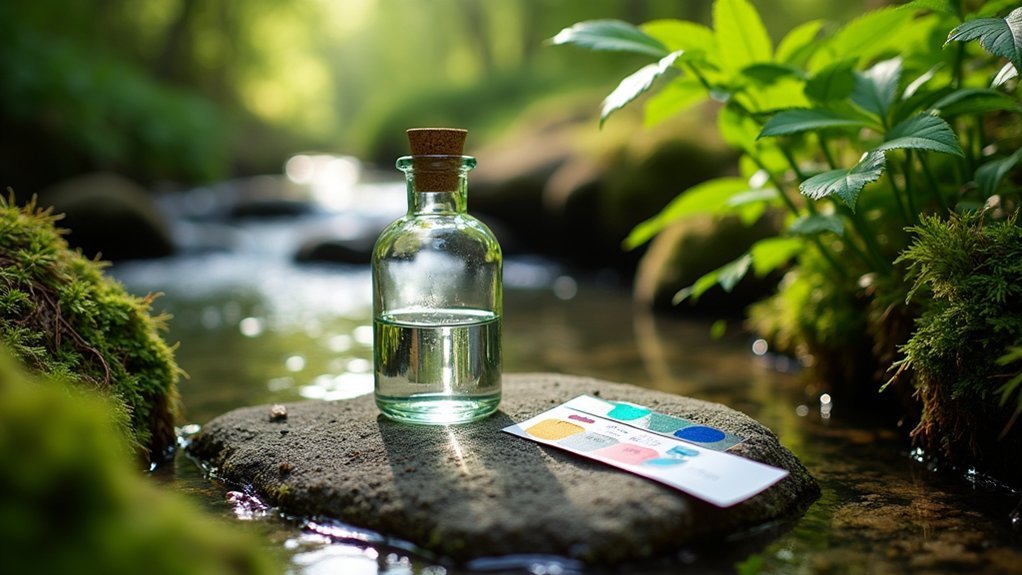
Although DIY testing kits offer quick and convenient ways to assess stream water quality, they often provide only a partial picture compared to professional laboratory analysis. Water test kits like Packtest can identify nutrient levels rapidly, but they typically underestimate contamination by about 20%, with one in five samples appearing cleaner than they actually are.
| DIY Testing | Professional Laboratory |
|---|---|
| Immediate results | 1-3 day turnaround time |
| Cost: $2-15 per parameter | Cost: $50-300 per analysis |
| Categorizes into broad bands | Precise measurements |
| Limited microbial testing | EPA 1603 analysis for E. coli |
| No regulatory compliance | FSMA PSR compliance |
While you'll appreciate the flexibility of self-sampling methods, professional testing remains essential for regulatory compliance and audit documentation, especially when harvesting wild foods where water safety is paramount.
Seasonal Variations in Urban Stream Bacterial Levels
Spring runoff carries winter's accumulated pollutants into urban streams, often pushing bacterial counts well beyond the safe threshold of 126 CFU/100 mL for E. coli.
You'll notice heightened contamination risks when harvesting wild foods near these waterways during this period, particularly after heavy rainfall events wash additional pollutants from impervious surfaces.
Testing water quality becomes especially vital in early spring, as the seasonal bacterial spike can compromise the safety of otherwise abundant wild edibles.
Subheading Discussion Points
Because urban stream ecosystems respond dramatically to environmental changes throughout the year, understanding seasonal bacterial fluctuations is essential for safe wild food harvesting.
You'll find bacterial levels typically spike during spring and summer months when warmer temperatures accelerate bacterial growth. These seasonal patterns directly impact when you should deploy water test kits to guarantee safety.
Rainfall events greatly influence bacterial counts, with wet weather runoff carrying fecal coliforms and E. coli from streets and agricultural areas into urban waterways.
Many streams exceed the safe E. coli threshold of 126 CFU/100mL during these peak bacterial seasons. For reliable results, test your harvesting site's water at least three times per season, particularly after rain events when bacterial concentrations are highest.
Spring Runoff Impact
When snow begins to melt and spring rains arrive, urban streams experience their most challenging bacterial conditions of the year. You'll find E. coli levels frequently exceeding the safe threshold of 126 CFU/100mL during this period as stormwater washes accumulated pollutants into waterways.
| Season | Bacterial Risk | Testing Frequency |
|---|---|---|
| Early Spring | Very High | Weekly |
| Mid-Spring | High | Bi-weekly |
| Late Spring | Moderate | Monthly |
| Summer | Variable | Monthly |
| Fall | Low-Moderate | Monthly |
If you're planning to harvest wild foods near urban streams, invest in water test kits before collecting. Testing should occur at least three times: early spring when runoff begins, mid-season, and shortly before harvest. This precaution is essential as bacterial contamination can transfer to wild edibles, posing significant health risks even when plants appear clean.
Understanding E. Coli Testing for Wild Food Safety
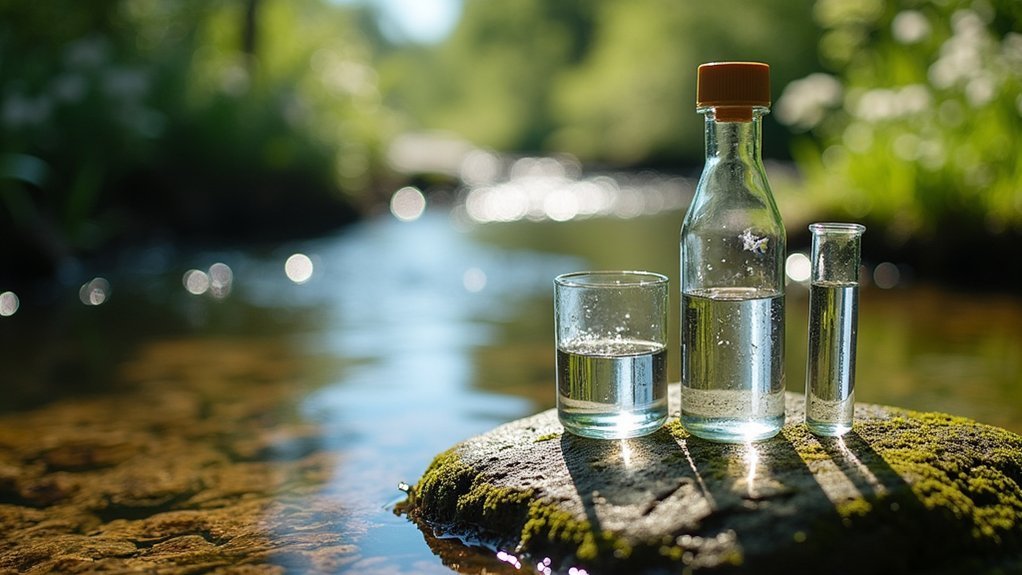
If you're harvesting wild foods from streams or nearby water sources, testing for generic E. coli is essential to guarantee your foraged items won't make anyone sick. The acceptable threshold is 126 CFU or MPN or less to comply with food safety regulations.
Consider using reliable water test kits that follow the EPA 1603 analysis method, which meets both FSMA Produce Safety Rule requirements and third-party audit standards.
Select test kits using EPA 1603 method for compliance with FSMA regulations and third-party audit requirements.
You'll need to test surface water at least three times per season, while annual testing is sufficient for irrigation sources.
If your results exceed safe levels, don't harvest. Instead, switch to an alternative water source, investigate potential contamination causes, and implement corrective measures before retesting.
How Rainfall Events Impact Stream Water Quality
Rainfall dramatically changes the safety profile of streams where you might harvest wild foods. When it rains, runoff carries nitrates, phosphates, and harmful bacteria into waterways, greatly increasing contamination levels.
Water test kits often reveal alarming spikes in E. coli and total coliforms immediately following storms.
You'll need to be strategic about timing your harvests. Research shows that stream contamination can persist for days after rainfall events. Wait at least 48 hours before collecting wild foods from affected areas to allow pollutants to dilute and settle. Even then, don't assume safety without verification.
Regular testing with water test kits before and after rain events is essential, especially if you're using stream water for irrigation or if your wild foods come into direct contact with the water.
Reading and Interpreting Water Test Results
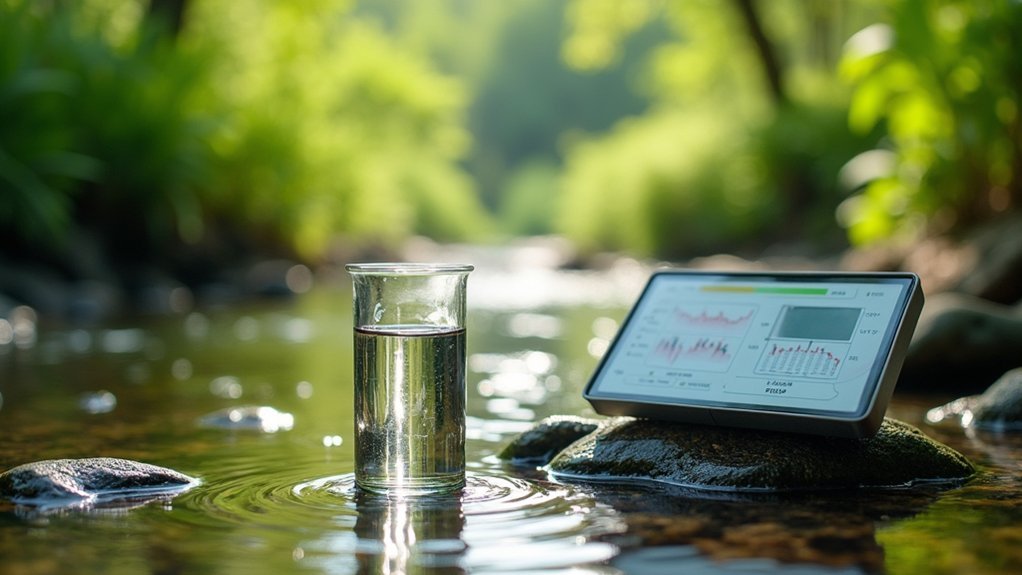
Understanding your water test results correctly determines whether your wild food harvesting site is safe or potentially dangerous.
When reviewing laboratory reports from water test kits, focus on the generic E. coli measurements, which should be 126 CFU or MPN or less for safe harvesting conditions.
Remember that presence/absence tests won't satisfy FSMA PSR compliance requirements—you'll need EPA 1603 analysis for accurate quantification.
Test your stream water at least three times per season: at irrigation start, mid-season, and pre-harvest.
If your results exceed acceptable thresholds, inspect your water system for contamination sources and consider alternative water supplies.
Always document all test results and corrective actions taken—this documentation is essential for audits and demonstrates your commitment to harvesting safe wild foods.
Identifying Safe Harvesting Zones Along Urban Waterways
While urban waterways offer abundant wild food harvesting opportunities, they require extra caution due to their proximity to pollution sources. Testing water quality at least three times per season using reliable water test kits helps identify areas with E. coli levels below 126 CFU, indicating safer harvesting zones.
To locate safer harvesting spots:
- Map potential contamination sources like storm drains, sewage outfalls, and industrial discharge points, then harvest at least 100 yards upstream from these locations.
- Conduct multiple water tests after rainfall events when pollutant levels typically spike.
- Establish sampling points along the waterway to identify patterns, creating a "safety map" of areas consistently meeting the EPA 1603 analysis standards.
Regular monitoring transforms uncertain urban foraging into a safer, more reliable food source.
Legal Standards and Guidelines for Urban Stream Safety
Beyond identifying safe harvesting zones, you'll need to navigate specific legal requirements that govern water quality for wild food harvesting. The USDA and FSMA Produce Safety Rule mandate zero total coliforms and non-detectable generic E. coli levels in harvesting water.
| Standard | Test Frequency | Recommended Method |
|---|---|---|
| FSMA PSR | 3× per season | EPA 1603 analysis |
| Well Water | Annual testing | Certified water test kits |
| Surface Water | Frequent monitoring | Lab verification |
You'll need to test stream water at critical points: start of irrigation, mid-season, and pre-harvest. Document all test results and corrective actions taken. Surface water requires more vigilant testing than well water due to environmental variability. Using approved testing methods guarantees compliance with legal standards and helps safeguard the quality of your wild harvests.
Urban Pollutant Sources and Their Effects on Foraged Foods
Urban streams face contamination from a multitude of pollutants that directly impact the safety of wild foods harvested nearby.
Before collecting wild greens or mushrooms near urban waterways, understanding these contaminants is essential for your safety.
Water analysis reveals three primary threats:
- Heavy metals (lead, cadmium, mercury) from industrial runoff can accumulate in foraged plants and fungi, creating serious health hazards when consumed.
- Agricultural nutrients and urban wastewater trigger toxic algal blooms that contaminate nearby vegetation and waterways.
- Pathogens like E. coli and persistent chemicals including pesticides and pharmaceuticals can transfer to wild foods through water contact or soil absorption.
These pollutants often bioaccumulate in foraged species, making regular water quality testing vital before harvesting wild foods from urban environments.
Frequently Asked Questions
How Do You Test Stream Water for Drinking?
You'll need to test stream water for total coliforms and E. coli using EPA 1603 analysis. Collect samples directly from the stream, keep them on ice, and deliver to a lab within six hours.
How Often Should Irrigation Water Be Tested?
You should test well water for irrigation annually. For surface water, test at least three times during the growing season—beginning, middle, and pre-harvest. Always verify that E. coli levels remain below 126 CFU/MPN for compliance.
What Do You Test River Water For?
When testing river water, you'll primarily test for generic E. coli levels (≤126 CFU/MPN), total coliforms, and use EPA 1603 analysis. These tests guarantee water safety for harvesting and help maintain compliance with regulations.
What Is the USDA Water Test?
The USDA water test checks for total coliforms and E. coli. You'll need to make certain your water has non-detectable levels of bacteria to comply with food safety standards for harvesting and processing operations.
In Summary
You've now gained essential knowledge to test your local streams before harvesting wild foods. Remember, water quality directly impacts your foraged foods' safety. Don't rely solely on appearances—regular testing using both DIY methods and occasional lab analysis will serve you well. By understanding bacterial contaminants, seasonal variations, and legal standards, you'll confidently identify safe harvesting zones while protecting yourself from urban pollutants.





Leave a Reply